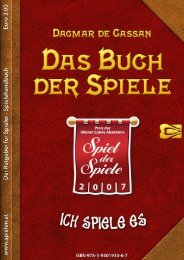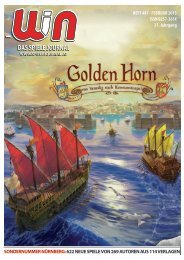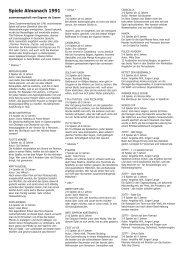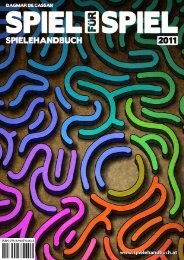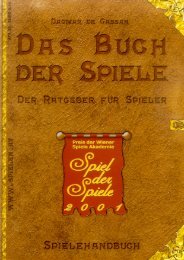THE GAMES JOURNAL - Österreichisches Spiele Museum
THE GAMES JOURNAL - Österreichisches Spiele Museum
THE GAMES JOURNAL - Österreichisches Spiele Museum
You also want an ePaper? Increase the reach of your titles
YUMPU automatically turns print PDFs into web optimized ePapers that Google loves.
GAME OF <strong>THE</strong> YEAR 2012 IN FRANCE<br />
TAKENOKO<br />
BAMBOO, WATER AND A PANDA<br />
The recipe for a good game is simple: You<br />
need a good designer, a good editor and<br />
one or two good ideas. To guarantee success,<br />
you also take good illustrators and<br />
component designers, and an enticing<br />
topic with rules that are easy but not simple.<br />
Then you pay attention to the duration<br />
of the game, so that it keeps being fun and<br />
pack all into a pretty box, full of beautiful<br />
components. For Takenoko, as you might<br />
guess by now, all this is true. For the �rst<br />
time on shop shelves in 2011, it was already<br />
sold out at Christmas time in most shops.<br />
And it only seems logical that the game has<br />
received its �rst award, Game of the Year<br />
2012 in France.<br />
The designer of the game, Antoine Bauza,<br />
has established himself as indispensable<br />
in the game community within the last �ve<br />
years. He can record one success after the<br />
other in very di�erent areas. So, his “7 Wonders”,<br />
a world-wide award-winner, should<br />
not gloss over the fact how vastly di�erent<br />
his other designs are, for instance “P’tites<br />
Witches“, an introduction for children into<br />
the genre of role-playing games, “Monster<br />
unterm Bett / La Chasse aux monstres /<br />
Monster Chase “ as a game for a very young<br />
user group, or Hanabi, his innovation in the<br />
genre of cooperative games.<br />
Takenoko takes us to Japan, a country that<br />
the designer especially loves and has visited<br />
several times already. He was looking at a<br />
souvenir picture of his visit to the Tokyo zoo<br />
on which he is seen standing next to the<br />
sculpture of two cute pandas when he had<br />
the idea for this game. And so it came about<br />
that a symbol for China, the panda bear, is<br />
now appearing in a game that takes place in<br />
Japan. To explain the presence of this plantigrade<br />
in the Empire of the Rising Sun the<br />
designer tells the story that the Emperor of<br />
China has presented the Emperor of Japan<br />
with a Panda and thus has begun a tradition<br />
that today is part of the daily diplomatic/<br />
commercial relations.<br />
We sit in front of the plans of the Imperial<br />
Gardens in Tokyo and busy ourselves with<br />
expanding the gardens and enlarging the<br />
irrigated areas within the gardens. Due<br />
to this irrigation the bamboo plants grow<br />
especially beautiful and make our ambassador<br />
from China want to gobble it all up<br />
immediately. In order to win it will be really<br />
necessary to play all three colors of bamboo<br />
present in the gardens and to enlarge<br />
the gardens in a way that our plantigrade<br />
will always have enough bamboo sprouts<br />
available to satisfy his insatiable appetite. All<br />
this is governed by three kinds of objective<br />
cards, which players must complete in order<br />
to win the game.<br />
Seductive components<br />
When opening the box one is easily seduced<br />
by its contents. The board is made up<br />
in the course of the game by placement of<br />
the 28 land plots, represented by hexagonal<br />
cardboard tiles. On 27 of these plots bamboo<br />
can be grown, up to a maximum height<br />
of four sections which are stuck into each<br />
other. So, in theory, there should be 108<br />
bamboo sections, but in reality the 90 sec-<br />
tions included in the game are more than<br />
enough to play, because, on the one hand,<br />
the gardener cannot till and irrigate all of<br />
the plots and, on the other hand, Panda eats<br />
up a section of bamboo each time when<br />
it moves, this section is returned to stock<br />
later in the game. Players can also use additional<br />
irrigation channels to irrigate the<br />
plots further and also improvement chips to<br />
improve the plots.<br />
Gardener and Panda move along those<br />
plots, they are both nicely sculptured<br />
�gurines, in representative size and prettily<br />
painted, they do immediately catch<br />
your eye. The balance of the components is<br />
made up by a wooden die for weather and<br />
46 objective cards.<br />
Each player receives his own individual<br />
board which depicts icons for the various<br />
possible actions; furthermore there are<br />
three storage areas on these boards: A space<br />
for irrigation channels, a space to deposit<br />
improvement chips and the Panda stomach.<br />
Two markers for each player are used<br />
to mark the �ve actions from which you can<br />
choose in your turn. The editor even paid attention<br />
to the detail to print another pattern<br />
on each player’s markers. This distinction is<br />
TAKENOKO t<br />
OUR REVIEW<br />
of no practical use whatsoever, but it is a<br />
small detail showing the painstaking and<br />
loving attention the editors have paid to<br />
this game. It is not di�cult at all to �nd volunteers<br />
for a game when the components<br />
have been spread on the table.<br />
Please the Emperor<br />
In order to please the emperor his courtiers,<br />
represented by us, the four players in the<br />
game, do all that is in their power to simultaneously<br />
enlarge and irrigate the garden and<br />
to appease the insatiable appetite of the sacred<br />
animal. These tasks are represented by<br />
three kinds of objective cards. The �rst stack<br />
represents three or four land plots, arranged<br />
in geometrical shapes, which must be laid<br />
out in the garden in the same way in order<br />
to score the card: For instance, three pink<br />
plots in a row or four green plots arranged<br />
like a diamond. In order to score, you must<br />
�nd exactly this arrangement in the correct<br />
colors in the garden and make sure that<br />
each of these plots in irrigated to enable<br />
you to score the card!<br />
The second stack of objective cards comprises<br />
cards featuring bamboo plants of<br />
a given size, showing one, two, three or a<br />
maximum of four bamboo sections. In order<br />
to complete these objective cards you<br />
must �nd a bamboo plant of this height<br />
(one, two, three or four sections) on the plot<br />
of the correct color in the garden, and also<br />
the correct number, if more than one plant<br />
is shown.<br />
The third and last objective is to have the<br />
correct number of bamboo section in the<br />
correct colors on your individual board,<br />
stored in Panda’s stomach. You choose the<br />
correct pieces from all those Panda has eaten<br />
up so far for you, that is you must have<br />
the pieces on your own individual board<br />
and discard them back into stock to complete<br />
and score the card.<br />
The three colors of bamboo are not represented<br />
equally in the colors of the garden<br />
plots: There are eleven plots in green, nine<br />
plots in yellow and seven plots in pink color.<br />
Due to the scarcity of pink plots the objective<br />
cards showing this colors, are more dif-<br />
�cult to complete, but score more points<br />
towards winning the game, for the bamboo<br />
plants as well as for the sections eaten by<br />
Panda or for the plot arrangement cards.<br />
On the other hand, the green objective<br />
cards are easier to complete but are less<br />
rewarding. Of course you must take into account<br />
that those facts and the resulting tactics<br />
are known to other players, too. But you<br />
can use the knowledge of color frequency<br />
and memorizing the number of plots al-<br />
WIN The Games Journal now also available as eBook!<br />
www.gamesjournal.at For all information on that check our website.<br />
ISSUE 434 / FEBRUARY 2012 17<br />
8�<br />
François Ha�ner<br />
An interactive game without any element of aggression! The<br />
topic, charming and de�nitely non-violent, will please any<br />
family, for which purpose it was intended �rst of all. But it is<br />
also a challenge for experienced players. The components are<br />
of an especially beautiful and attractive design.




